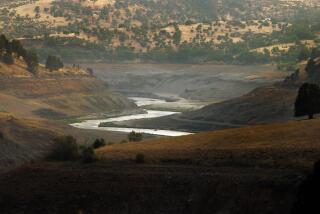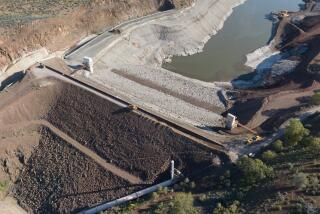They’re Overcoming Barriers to Protect One
- Share via
HADITHA DAM, Iraq — Even before Saddam Hussein’s regime was toppled, U.S. military planners knew that this mammoth hydroelectric dam about 150 miles northwest of the capital was important to Iraq’s future.
To prevent retreating Iraqi troops from destroying the dam and flooding the region, Army Rangers seized the site on the night of April 1, 2003, a week before the fall of Baghdad, while warplanes hammered an Iraqi army unit nearby.
Nearly two years later, as U.S.-led forces battle an insurgency that has targeted much of the war-ravaged country’s infrastructure, protecting the 10-story dam that provides electricity for a third of the country remains a priority.
The job is split between U.S. Marines and a company of soldiers from Azerbaijan.
The Marines, notoriously tough in their evaluation of other military forces, say the Azerbaijanis have been impressive with their discipline, respect for authority and careful handling of their weapons.
“If the Marines are an 8, the Azerbaijanis are at least a 4,” said Sgt. Refugio Llamas, 38, of San Jose. “The Iraqis, well, they’re not on the scale.”
The Marines, members of the 1st Battalion, 23rd Regiment, a reserve unit from Houston, provide security to the area’s towns and roadways. The Azerbaijanis, in their crisp tan and green field uniforms and pith helmets, are responsible for security inside the dam and within its fenced perimeter.
Each day, the Azerbaijanis search Iraqi dam workers as they arrive and leave. Some of the workers have made their displeasure known, but the soldiers appear unmoved.
“They don’t like us,” said Maj. Elkhan Shalbuzov, the top Azerbaijani officer. “Our soldiers tell them nothing. We are not here to talk to Arabian people but to catch terrorists.”
Since gaining independence in 1991 from the former Soviet Union, Azerbaijan has made military service mandatory for young men and sent troops to Kosovo and Afghanistan. The U.S. has responded with military aid for the nation of about 8 million people.
Haditha, Iraq’s second-largest hydroelectric dam, was a showpiece for the Hussein government. The structure was designed by Soviet engineers and built by 2,000 workers from Eastern Europe. After eight years, the first phase was completed in 1984.
During construction, the course of the Euphrates River was altered and archeological sites and small villages were flooded.
Before the U.S.-led invasion of Iraq in 2003, American officials worried that Iraqi forces would blow up the dam to swamp the region and slow the advance of coalition troops.
Officials now fear insurgents may strike Haditha to signal their determination and intimidate the populace.
No serious attempts to attack the dam have been made, though insurgents are active in the region, especially after a U.S.-led offensive in November drove many fighters out of Fallouja, 100 miles to the southeast.
Militants occasionally fire mortar shells at the dam, but the rounds fall hundreds of yards short.
A raid on an insurgent stronghold uncovered a diagram of the dam, its checkpoints and patrol routes.
Marines from the 4th Platoon of the Small Craft Company patrols the Euphrates and the dam’s immense reservoir, Lake Qadisiya, in small watercraft. They recently discovered several caches of weapons and explosives along the banks of the river, within striking distance of the dam.
Days later, a squad was ambushed by insurgents while on patrol.
A lance corporal was killed and a captain lost an arm.
The river unit is constantly on patrol while the Azerbaijanis staff the lookout towers.
The two military units live on opposite sides of the dam but share a chow hall and Internet room.
The Azerbaijanis are polite but reserved, and there’s little interaction between the two groups, as the chasm of language and culture appears to be too wide.
On the Marine side, signs of Texas are plentiful: a state flag above the dam and a “Texas Born, Texas Proud” sticker on the gun turret of a Humvee, among others. The Azerbaijanis watch their national equivalent of MTV.
The Americans and Azerbaijanis must use stairs: 290 of them in the structure.
Like much of the dam’s internal operations, the elevators do not work.
Haditha shows the deterioration common to Iraqi infrastructure during the final years of Hussein’s rule. Walls are moldy, some cracked and crumbling, and offices and workspaces smell of sulfur.
By one account, the structure was functioning at 30% capacity when the Army Rangers descended and rounded up the workers.
A $12-million improvement project was administered by Colorado-based CH2M Hill and overseen by the Army Corps of Engineers. Two turbines were rehabilitated and by last June, the dam was functioning at capacity for the first time since 1990, providing 660 megawatts of electricity.
The presence of the Azerbaijanis allows the Marines to launch missions in the countryside without worrying that insurgents might use their absence to attack the dam.
“No problem, we are here,” said Azerbaijani Lt. Rashad Garayev.
More to Read
Sign up for Essential California
The most important California stories and recommendations in your inbox every morning.
You may occasionally receive promotional content from the Los Angeles Times.










